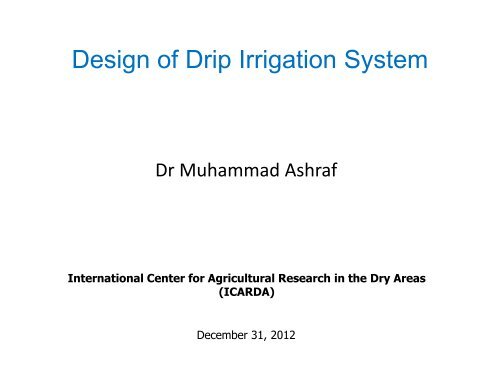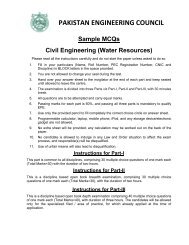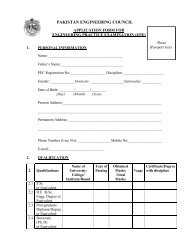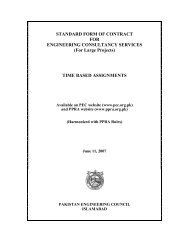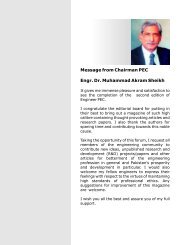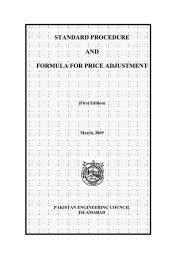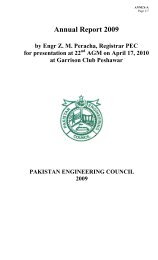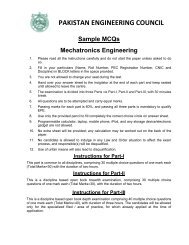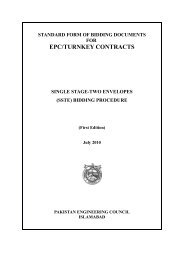Design of Drip Irrigation System
Design of Drip Irrigation System
Design of Drip Irrigation System
Create successful ePaper yourself
Turn your PDF publications into a flip-book with our unique Google optimized e-Paper software.
<strong>Drip</strong> <strong>Irrigation</strong>?<strong>Drip</strong> irrigation is the slow, precise application<strong>of</strong> water and nutrients directly to the plants'root zones in a predetermined pattern using apoint source.
A Typical Layout for <strong>Drip</strong> <strong>Irrigation</strong><strong>Drip</strong> <strong>Irrigation</strong> <strong>System</strong>
Components <strong>of</strong> <strong>Drip</strong> <strong>Irrigation</strong> <strong>System</strong>Head UnitPrime Mover (Motor/Engine)Water PumpG. I pipe fittingsBy pass valvesAir release valvesFiltersFlow meterNon-return valvesFertigation unitField UnitMain lineSub-main lineManifoldsLateral line with emittersValves (By pass, Flush andAir release)End PlugPressure gage1 bar = 10.2 m <strong>of</strong> water = 14.05 psi = 0.987 atms = 100 kPa = 1.02 kg/cm 2
Focus <strong>of</strong> <strong>Design</strong>• Apply water to meet peak crop water requirement• Maintain application and uniformity efficiencies at adesired level• Energy and water efficient system to keep initial capitaland operation cost as low as possible• Simple in operation and maintenance so that farmers canuse these systems without extensive training
Criteria for <strong>System</strong> Selection• Economic• Topographic (location, elevation, fieldboundary, shape/slope, area, location <strong>of</strong>pumping unit etc.)• Soil (type, soil moisture holding capacity,depth, intake rate)• Water supply (quantity, quality, temporalvariation)• Crop factors (crop, row-to-row and plant-toplantspacings)
<strong>Design</strong> Parameters• Area to be irrigated, type <strong>of</strong> plants, plant spacing and number <strong>of</strong> plantsper unit area• Peak water requirement <strong>of</strong> crop or plant• Selection <strong>of</strong> emitter type, number <strong>of</strong> emitter per plant and amount <strong>of</strong>water discharge per hour through each emitter• Water required to be pumped from the well. This depends uponhydrogeological conditions in the area and water requirement <strong>of</strong>plants/crop• Layout <strong>of</strong> the system considering topography, field shape and location <strong>of</strong>the water source• Calculating sectional flow based on number <strong>of</strong> emission devices and theirdischarge against known pressure• <strong>Design</strong> <strong>of</strong> main and lateral drip lines. This depends upon friction headlosses• Selection <strong>of</strong> filters and other equipment• Horse power <strong>of</strong> a pump set. This depends on discharge and the total headincluding friction losses over which water is to be lifted/pumped
Command Area Information• A command area map giving layout is necessary to plan anddesign a drip irrigation system• It may not be necessary to have a detailed contour plan but itis helpful if a plan showing the highest and lowest points alongwith well location is given• This enables proper design <strong>of</strong> main line and laterals
Discharge Capacity <strong>of</strong> a PumpQ = 27.78 (AD/RT)Where:Q = Discharge <strong>of</strong> pump (lps)A = Area (ha)D = Depth <strong>of</strong> irrigation (cm)R = No <strong>of</strong> days for which water is pumpedT = Duration <strong>of</strong> pumping (hrs/day)ExampleA= 5 haD = 100 cmR = 150 daysT = 6 hrs/dayQ = 15 lps
Selection <strong>of</strong> Type and Number <strong>of</strong> Emitters• Selection <strong>of</strong> type and number <strong>of</strong>emitters depends on the soiltypes, plant to plant distance <strong>of</strong>crop, age <strong>of</strong> the plant• The emitter is so selected thatapplication rate equals to theabsorption rate <strong>of</strong> soil• Generally, 30-70% <strong>of</strong> the area iswetted depending upon plantspacing, nature anddevelopment <strong>of</strong> root zone• Some times a loop with 3 to 4emitters is placed around eachplant to provide the requiredwetted area. This should beaway from the plant stem• If single emitter is provided, itmust be placed 15-30 cm. fromthe base <strong>of</strong> the plantSpace emitters equally apart2 – 180°3 – 120°4 – 90°
Layout <strong>of</strong> <strong>Drip</strong> <strong>Irrigation</strong> <strong>System</strong>• Water source and pumping plant location should belocated as close to the center <strong>of</strong> the irrigated area aspossible• The main line/manifold in a drip system preferablyshould follow land contour as closely as possible• If there is a slope, it should be used for compensatingpressure differences due to change in elevation• When water flows down slope, it allows longer lateralsfor a given pipe size or smaller pipe for a given length<strong>of</strong> lateral• A fall <strong>of</strong> 1 m in elevation is equivalent to an increase inpressure <strong>of</strong> about 0.1 bar• Running laterals uphill should be avoided whereverpossible.
<strong>Design</strong> <strong>of</strong> Mainline and Laterals The design <strong>of</strong> lateral pipe involves selection <strong>of</strong> requiredpipe size for a given length which can carry the requiredquantity <strong>of</strong> water to the plant In designing the lateral, the discharge and operatingpressure at emitters are required to be known The allowable pressure drop in mainline and lateralsdepend upon the operating pressure required at emitters Pressure variation along the lateral line should notexceed 10% <strong>of</strong> the design lateral pressure
Energy/Head LossesEnergy losses occur in the pipeline due to friction and elevationchanges. The most commonly used equation in irrigation calculations isthe Hazen-Williams formula:h = f[{ K(Q/C) 1.852 }/ { D 4.87 }]* ( L + Le)Where:H f is the frictional head loss (m)K = 1.21 x 1010Q is the pipeline discharge (lps)C is the friction coefficient for pipe sectionsD is the inside diameter (mm)L is the pipeline length (m)Le is the equivalent length <strong>of</strong> pipe and accessories
Hazen-Williams Equation (C=150)∆ H = 15.27 (Q 1.852 ) LD 4.871∆ H = Energy drop by friction (m)Q = Flow rate <strong>of</strong> the pipe (litre/sec)L = Length <strong>of</strong> the pipe (m)D = Diameter <strong>of</strong> pipe (m)
Friction CoefficientsPipe materialF – mm (Darcy- C (Hazen-Williams)Weisbach)PVC and PE 0.0015 - 0.007 140 -150Asbestos-cement 0.3 130-140New steel 0.045 - 0.09 110-120Five year old steel 0.15 - 4.0 80 - 90Steel with internalconcrete coating0.3 - 1.0 110 - 120Concrete 0.3 - 5.0 90 - 100
Frictional Head Losses (m/100 m) for 13 mm <strong>of</strong> PE pipeused as lateralsDischarge Fractional Losses (m/100 m)(lps) C = 120 C = 130 C = 140 C = 1500.01 0.13 0.11 0.10 0.080.02 0.46 0.39 0.34 0.300.03 0.97 0.84 0.73 0.640.04 1.65 1.43 1.24 1.090.05 2.50 2.15 1.88 1.65Source: PARC (2001)
Frictional Head Losses (m/100 m) for 16 mm Diameter PE Pipe used as LateralsDischargeFractional Losses (m/100 m)(Lps)C=120 C=130 C=140 C=1500.01 0.05 0.04 0.03 0.030.02 0.17 0.14 0.13 0.110.03 0.35 0.30 0.27 0.230.04 0.60 0.52 0.45 0.400.05 0.91 0.78 0.68 0.600.06 1.27 1.10 0.96 0.840.07 1.70 1.46 1.27 1.120.08 2.17 1.87 1.63 1.440.09 2.70 2.33 2.03 1.790.10 3.28 2.83 2.47 2.17Source: PARC (2001)
Frictional Head Losses (m/100 m) for 25 mm Diameter <strong>of</strong> PE pipe used as ManifoldsDischargeFractional Losses(m/100 m)(Lps)C=120 C=130 C=140 C=1500.10 0.37 0.32 0.28 0.250.12 0.52 0.45 0.39 0.350.14 0.70 0.60 0.52 0.460.16 0.89 0.77 0.67 0.590.18 1.11 0.96 0.83 0.730.20 1.35 1.16 1.01 0.890.22 1.61 1.39 1.21 1.060.24 1.89 1.63 1.42 1.250.26 2.19 1.89 1.65 1.450.28 2.51 2.17 1.89 1.660.30 2.86 2.46 2.15 1.890.32 3.22 2.78 2.42 2.130.34 3.60 3.11 2.71 2.380.36 4.00 3.45 3.01 2.650.38 4.43 3.82 3.33 2.930.40 4.87 4.20 3.66 3.22Source: PARC (2001)
Frictional Head Losses (m/100 m) for 31.25 mm Diameter PE Pipe usedas ManifoldsDischarge(lps)Fractional Losses (m/100 m)C=120 C=130 C=140 C=1500.20 0.45 0.39 0.34 0.300.22 0.54 0.47 0.41 0.360.24 0.64 0.55 0.48 0.430.26 0.74 0.64 0.56 0.490.28 0.85 0.73 0.64 0.560.30 0.96 0.83 0.72 0.640.32 1.09 0.94 0.82 0.720.34 1.21 1.05 0.91 0.800.46 1.35 1.16 1.02 0.890.38 1.49 1.29 1.12 0.990.40 1.64 1.42 1.23 1.090.42 1.80 1.55 1.35 1.190.44 1.96 1.69 1.47 1.300.46 2.13 1.83 1.60 1.410.48 2.30 1.98 1.73 1.520.50 2.48 2.14 1.87 1.640.52 2.67 2.30 2.01 1.770.54 2.86 2.47 2.15 1.890.56 3.06 2.64 2.30 2.020.58 3.27 2.82 2.46 2.160.60 3.48 3.00 2.61 2.30Source: PARC (2001)
Frictional Head Losses (m/100m) for 37.5 mm Diameter <strong>of</strong> PE pipe used for ManifoldsDischarge(Lps)Fractional Losses (m/100 m)C=120 C=130 C=140 C=1500.30 0.40 0.34 0.30 0.260.32 0.45 0.39 0.34 0.300.34 0.50 0.43 0.38 0.330.36 0.56 0.48 0.42 0.370.38 0.61 0.53 0.46 0.410.40 0.68 0.58 0.51 0.450.42 0.74 0.64 0.56 0.490.44 0.81 0.69 0.61 0.530.46 0.88 0.75 0.66 0.580.48 0.95 0.82 0.71 0.630.50 1.02 0.88 0.77 0.680.52 1.10 0.95 0.83 0.730.54 1.18 1.02 0.89 0.780.56 1.26 1.09 0.95 0.830.58 1.34 1.16 1.01 0.890.60 1.43 1.23 1.08 0.950.62 1.52 1.31 1.14 1.010.64 1.61 1.39 1.21 1.070.66 1.71 1.47 1.28 1.130.68 1.80 1.56 1.36 1.190.70 1.90 1.64 1.43 1.260.72 2.01 1.73 1.51 1.330.74 2.11 1.82 1.59 1.400.76 2.22 1.91 1.67 1.470.78 2.33 2.01 1,75 1.540.80 2.44 2.10 1.83 1.610.82 2.55 2.20 1.92 1.690.84 2.67 2.30 2.01 1.770.86 2.79 2.40 2.10 1.840.88 2.91 2.51 2.19 1.920.90 3.03 2.62 2.28 2.010.92 3.16 2.72 2.37 2.090.94 3.29 2.83 2.47 2.170.96 3.42 2.95 2.57 2.260.98 3.55 3.06 2.67 2.351.00 3.69 3.18 2.77 2.44Source: PARC (2001)
Frictional Head Losses (m/100 m) for 50 mm Diameter <strong>of</strong> PE pipe used for MainlinesDischarge(Lps)Fractional Losses (m/100 m)C=120 C=130 C=140 C=1501.0 0.91 0.78 0.68 0.601.2 1.27 1.10 0.96 0.841.4 1.69 1.46 1.27 1.121.6 2.17 1.87 1.63 1.431.8 2.70 2.33 2.03 1.782.0 3.28 2.83 2.46 2.172.2 3.91 3.37 2.94 2.592.4 4.60 3.96 3.45 3.042.6 5.33 4.60 4.01 3.532.8 6.11 5.27 4.60 5.043.0 6.95 5.99 5.33 4.60Source: PARC (2001)
Frictional Head Losses (m/100 m) for 62.5 mm Diameter <strong>of</strong> PE pipe used for MainlinesDischarge(lps)Fractional Losses (m/100 m)C=120 C=130 C=140 C=1502.0 1.11 0.95 0.83 0.732.2 1.32 1.14 0.99 0.872.4 1.55 1.34 1.17 1.032.6 1.80 1.55 1.35 1.192.8 2.06 1.78 1.55 1.363.0 2.34 2.02 1.76 1.553.2 2.63 2.28 1.98 1.753.4 2.95 2.55 2.22 1.953.6 3.28 2.83 2.47 2.173.8 3.63 3.13 2.73 2.404.0 3.99 3.44 3.00 2.644.2 4.37 3.77 3.28 2.894.4 4.76 4.11 3.58 3.154.6 5.17 4.46 3.89 3.424.8 5.60 4.82 4.21 3.705.0 6.04Source: PARC (2001)5.20 4.54 3.99
Frictional Head Losses (m/100 m) for 75 mm Diameter <strong>of</strong> PE pipe used for MainlinesDischarge(Lps)Fractional Losses (m/100 m)C=120 C=130 C=140 C=1503.0 0.96 0.83 0.72 0.643.2 1.09 0.94 0.82 0.723.4 1.22 1.05 0.91 0803.6 1.35 1.17 1.02 0.893.8 1.49 1.29 1.12 0.994.0 1.64 1.42 1.23 1.094.2 1.80 1.55 1.35 1.194.4 1.96 1.69 1.47 1.304.6 2.13 1.84 1.60 1.414.8 2.30 1.99 1.73 1.525.0 2.48 2.14 1.87 1.645.2 2.67 2.30 2.01 1.775.4 2.86 2.47 2.15 1.895.6 3.06 2.64 2.30 2.035.8 3.27 2.82 2.46 2.166.0 2.48 3.00 2.62 2.306.2 3.70 3.19 2.78 2.456.4 3.92 3.38 2.95 2.606.6 4.15 3.58 3.12 2.756.8 4.39 3.78 3.30 2.907.0 4.63 3.99 3.48 3.067.2 4.88 4.21 3.67 3.237.4 5.13 4.43 3.86 3.407.6 5.39 4.65 4.05 3.577.8 5.66 4.88 4.25 3.748.0 5.93 5.11 4.46 3.928.2 6.21 5.35 4.67 4.118.4 6.49 5.60 4.88 4.298.6 6.78 5.85 5.10 4.498.8 7.08 6.10 5.32 4.689.0 7.38 6.36 5.54 4.889.2 7.68 6.62 5.77 5.089.4 8.00 6.89 6.01 5.299.6 8.31 7.17 6.25 5.509.8 8.64 7.45 6.49 5.7110.0 8.97 7.73 6.74 5.93Source: PARC (2001)
Frictional Head Loss (m/100 m) for 100 mm Diameter <strong>of</strong> PE pipe used for MainlinesDischarge(lps)Fractional Losses (m/100 m)C=120 C=130 C=140 C=1505.0 0.61 0.53 0.46 0.405.2 0.66 0.57 0.49 0.445.4 0.71 0.61 0.53 0.475.6 0.75 0.65 0.57 0.505.8 0.81 0.69 0.61 0.536.0 0.86 0.74 0.64 0.576.2 0.91 0.79 0.68 0.606.4 0.97 0.83 0.73 0.646.6 1.02 0.88 0.77 0.686.8 1.08 0.93 0.81 0.727.0 1.14 0.98 0.86 0.757.2 1.20 1.04 0.90 0.807.4 1.26 1.09 0.95 0.847.6 1.33 1.15 1.00 0.887.8 1.39 1.20 1.05 0.928.0 1.46 1.26 1.10 0.978.2 1.53 1.32 1.15 1.018.4 1.60 1.38 1.20 1.068.6 1.67 1.44 1.26 1.108.8 1.74 1.50 1.31 1.159.0 1.82 1.57 1.37 1.209.2 1.89 1.63 1.42 1.259.4 1.97 1.70 1.48 1.309.6 2.05 1.77 1.54 1.359.8 2.13 1.83 1.60 1.4110.0 2.21 1.90 1.66 1.4610.2 2.29 1.98 1.72 1.5210.4 2.38 2.05 1.79 1.5710.6 2.46 2.12 1.85 1.6310.8 2.55 2.20 1.91 1.6811.0 2.64 2.27 1.98 1.7411.2 2.72 2.35 2.05 1.8011.4 2.82 2.43 2.12 1.8611.6 2.93 2.51 2.19 1.9211.8 3.00 2.59 2.26 1.9912.0 3.10 2.67 2.33 2.05Source: PARC (2001)
Minor Head LossesThe head loss associated with fittings/valves is calculated using equationKv = (Q/∆P) 0.5whereKv = Flow factor (m 3 /hr), Q = Flow rate (m 3 /hr) and ∆P = Pressure drop(bars)Fitting ValveLosscoefficient KFitting, valveLosscoefficient K45° standard elbow 0.35 Gate valve, open 0.2090° standard elbow 0.75 Three-fourths open 0.90Coupling or union 0.04 One-half open 4.50Tee, along run 0.40 One-fourth open 24.00Branching flow 1.00 Globe valve, open 6.40Ball check valve, open 70.00 One-half open 9.5Example: If Kv = 50 m 3 /hr and Q = 30 m 3/ hr, then ∆P = 0.36 bar = 3.6 m
Head Losses in Valves and Accessories
Power Requirement• The HP <strong>of</strong> pump set required is based upon designdischarge, total operating head and efficiency <strong>of</strong> pumpingsystem• Where the total head is the sum <strong>of</strong> total static head andfriction losses in the system• Overall efficiency recommended for high pressurepumping systems is as under:• Electric motor operated systems = 50%• Diesel engine operated systems = 40%
<strong>Design</strong> <strong>of</strong> Prime MoverPower requirement for the prime mover can bedetermined by:Where:HP = QH/(76 x Engine efficiency)Q = Discharge (lps)H= Total head (m)Example:H = 30 mQ = 15 lpsEngine HP: 12Motor HP: 15
Pump SelectionPump selection is based on the:• Required pressure• <strong>Design</strong>ed discharge and• Size <strong>of</strong> prime mover
Example<strong>Design</strong> a drip irrigation system for the following data:Area: 30 acre = 400 m x 300 mTopography: FlatCrop: CitrusSpacing: 6.1 m x 6.1 mWater source: Tubewell at the center <strong>of</strong> the fieldSuction lift: 3 mDelivery lift: 3 mTubewell discharge: 15 lpsTotal no. <strong>of</strong> plants: 3225Emitter discharge: 4 lphTotal emitters (4 per plant): 12900Total flow rate: 51599 lph = 14.3 lps
Layout <strong>of</strong> the Farm
Example (cont)• Divide the area into 4 blocks (7.5 acre x 4)• Lateral length : 75 m• Lateral inside diameter : 16 mm• No. <strong>of</strong> emitters/lateral: 49• Discharge <strong>of</strong> emitters: 197 lph = 0.05 lps• Head loss in lateral (0.91 m/100 m): 0.68 m• Sub main 1• Length : 200 m• Diameter: 62.5 mm• No. <strong>of</strong> laterals on the sub main: 66• Total discharge <strong>of</strong> the sub main: 12984 lph = 3.6 lps• Head loss in sub main (2.78 m/100 m): 5.56 m• No. <strong>of</strong> sub mains: 4• Total discharge <strong>of</strong> main line (4 sub mains): 51934 lph: 14.4 lps• Diameter <strong>of</strong> main line : 100 mm• Length <strong>of</strong> main line: 150 m• Head loss in main line (2.67 m/100 m): 4 m
Total Head• Operating pressure : 10 m• Suction lift: 3 m• Elevation lift: ± 0• Delivery lift: 3 m• Head loss in laterals: 0.68 m• Head loss in sub mains: 5.56 m• Head loss in main line: 4 m• Misc head losses (fittings, valves etc): 10 m• Total dynamic head : 36.2 m• Discharge:14.4 lps• Motor HP (50% efficiency) 13.7• Engine HP (40% efficiency) 17.2
<strong>Irrigation</strong> Scheduling• Crop : Citrus• Area: 30 acres• Root zone depth: 80 cm• Maximum allowable deficit (MAD): 40%• ETo (mm/day): 8 mm/day• Kc: 0.9• Soil texture: Loamy clay• Bulk density: 1.4 gm/ml• Field capacity: 32%• Wilting point: 15%• Available moisture: 17%• Daily peak season water demand: 7.2 mm/day• Gross daily demand (mm/day), assuming 90% efficiency: 8 mm/day• Available moisture by volume: 0.24 cm 3 <strong>of</strong> water/cm 3 <strong>of</strong> soil• Total available moisture: 19.04 cm• Water content at 40% MAD: 7.62cm• No. <strong>of</strong> day after irrigation is due: 10 days
<strong>Irrigation</strong> SchedulingCanopydiameter(m)Gross CWR(liters/day)Time <strong>of</strong> irrigation with 4emitters (hrs/day)2 25 1.33 57 2.84 100 5.0
Energy/Head LossesHead loss in pipes with Multiple , equally Spaced OutletsFlow <strong>of</strong> water in a pipe having multiple, equally spaced outlets will have less headloss than a similar pipe transmitting the entire flow over its length because theflow steadily diminishes each time an outlet is passed. Christiansen developedthe concept <strong>of</strong> a "F factor", which accounts for the effect <strong>of</strong> the outlets. When thefirst outlet is one outlet spacing from the lateral or manifold inlet:in which,F = [1/(m+1)] + [1/2N] + [ {m-1} 0.5 / 6N 2 ]F =m =m =N =fraction <strong>of</strong> the headloss under constant discharge conditionsexpected with the multiple outlet case;1.85 for Hazren-Williams equation;2.0 for the Darcy-Weisbach equation; andnumber <strong>of</strong> outlets along the pipe.
Increase the length <strong>of</strong> the pipe for:Elbow (90°) : 60 times the internal diameter <strong>of</strong> thepipeElbow (45°): 30 times the internal diameter <strong>of</strong> thepipeGate valve (side): 50 times the internal diameter <strong>of</strong>the pipeGate valve (straight): 150 times the internaldiameter <strong>of</strong> the pipe


